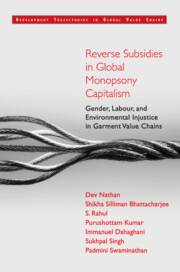 Reverse Subsidies in Global Monopsony Capitalism
Reverse Subsidies in Global Monopsony Capitalism Published online by Cambridge University Press: 21 January 2022
As laid out in Chapter 4, labour-intensive production processes and payments below living wages are structural features of the global garment industry. Chapter 4 laid out a framework for understanding how global value chains (GVCs) drive down wages and structurally reproduce labour subsidies. This chapter, and Chapter 6 that follows, zoom in on the impact of wage subsidies borne by garment production line workers—a predominantly female workforce of internal and international migrants employed at the base of global production networks.
How do women production line workers subsidize the functioning of garment value chains? This chapter presents a two-part framework for understanding the extractive labour subsidies borne by women workers on garment production lines: overwork subsidies and discard subsidies. Each of these labour subsidies is largely experienced by women workers through bodily and embodied processes. Overwork subsidies refer to subsidies extracted from women workers through exploitative labour practices in the garment sector. In order to meet the fast-fashion production targets, garment workers on production lines work extended hours for below living wages.
Overwork subsidies manifest as physical calorie deficits: garment production line workers earn wages that permit them to afford food amounting to fewer calories per day than they expend working on production lines. This calorie deficit is magnified for women who also expend energy on unremunerated care and reproductive work. Prolonged calorie restriction has severe health implications, including reduced fertility and weaker bones. In short, women workers on garment production lines subsidize the global garment industry by absorbing health impacts with long-term consequences. These health impacts are compounded by poor working conditions, including long hours performing repetitive manual tasks under exposure to heat, noise, dust, and chemicals.
Yet another subsidy, which we refer to as a discard subsidy, captures the costs borne by women garment workers when they age out of garment sector employment. Due to industry preference for women below the age of 35, young women workers provide overwork subsidies resulting in long-term health costs until they age out of employment—typically before they become eligible to receive seniority or severance benefits. These outcomes for women workers are not just technical shortcomings in the organization of work but also structural outcomes of global garment production regimes.
To save this book to your Kindle, first ensure [email protected] is added to your Approved Personal Document E-mail List under your Personal Document Settings on the Manage Your Content and Devices page of your Amazon account. Then enter the ‘name’ part of your Kindle email address below. Find out more about saving to your Kindle.
Note you can select to save to either the @free.kindle.com or @kindle.com variations. ‘@free.kindle.com’ emails are free but can only be saved to your device when it is connected to wi-fi. ‘@kindle.com’ emails can be delivered even when you are not connected to wi-fi, but note that service fees apply.
Find out more about the Kindle Personal Document Service.
To save content items to your account, please confirm that you agree to abide by our usage policies. If this is the first time you use this feature, you will be asked to authorise Cambridge Core to connect with your account. Find out more about saving content to Dropbox.
To save content items to your account, please confirm that you agree to abide by our usage policies. If this is the first time you use this feature, you will be asked to authorise Cambridge Core to connect with your account. Find out more about saving content to Google Drive.